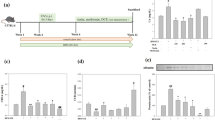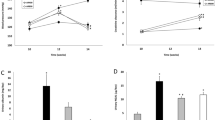Summary
This study examined the potential roles of astragalus and angiotensin II: type 2 receptor (AT2) in rats with streptozotocin (STZ)-induced diabetic cardiomyopathy. Of 52 female 4-weekold Wistar rats treated with high glucose and lipid diet to induce insulin resistance, 7 treated with sodium citrate buffer (pH=4.5) served as controls (con1) and the other 45 were treated by intraperitoncal injection (ip) of STZ to induce type 2 diabetes. After 20 weeks, the maximal velocity decrease of pressure per second in left ventricle within the period of isovolumic relaxation (−dp/dtmax was detected by inserting cannula through right carotid artery. Of the 45 rats, 24 with −dp/dtmax 700 mmHg/s (1 mmHg=0.133 kPa) developing diabetic cardiomyopathy were grouped as follows: 7 treated with double distilled H2O (ip) were included in control group 2 (con2); other 8 treated with AT2 agonist (CGP42112A, ip) were included in experimental groupl (exp); 9 treated with astragalus (po) constituted experimental group 2 (exp2). All injections lasted 4 weeks (qd) and the heart weight (HW) was recorded. Cardiomyocyte apoptosis index (CAI), mRNA of AT2 and Bel-2 as well as AT2 and Bcl-2 protein values in cardiomyocytes were also measured. Our results showed that −dp/dtmax in expl, exp2 and con2 were much lower than those in con1 (P<0.01). CAI and AT2 in both mRNA and protein in con1 were lower than those in the other three groups (P<0.01). The three parameters above were higher in expl but less in exp2 than those in con2, respectively (P<0.01). The three parameters and HW in expl were much higher than those in exp2 (P<0.01). Changes of Bcl-2 were opposite to those of AT2. Our results suggested that high expression of AT2 might accelerate the apoptosis of cardiomyocytes in diabetic rats and play an important role in precipitating diabetic cardiomyopathy and astragalus protects diabetic rats from developing cardiomyopathy by downregulating AT2.
Similar content being viewed by others
References
Hamby R, Zoneraim S, Sherman L. Diabetic cardiomyopathy. JAMA, 1974, 229: 1749
Thompson E W. Structural manifestations of diabetic cardiomyopathy in the rat and its reversal by insulin treatment. Am J Ana, 1988, 182: 270
Zhu X X, Zhou X P, Zhong X Let al. Streptozocin induced cardiomyopathy in diabetic rats. Chin Med J, 1993, 106: 463
Fein F S, Komstein L B, Strobecket J Eet al. Altered myocardial mechanics in diabetic rats. Cir Res, 1980; 47: 922
Tahilini A G, Vadlamudi R V S V, MeNell A J H. Prevention and reversal of altered myocardial function in diabetic rats by insulin treatment. Can J Physiol Pharmacol, 1983, 61: 516
Ni Z S, Zheng J C, Wang D Wet al. Primary study on the mRNA expression of angiotensin II type 2 receptor and cytokines in the kidney of diabetic rats (Chinese). Chin J Chin Herbs, 2004, 23(1): 54
Ichihi S, Senbonmatsu T, Edward Pet al. Angiotensin II type 2 receptor is essential for left ventricular hypertrophy and cardiac fibrosis in chronic angiotensin II induced hypertension. Circulation, 2001, 104: 346
Matsumoto T, Ozono R, Oshima Tet al. Type 2 angiotensin II receptor is downregulated in cardiomyocytes of patients with heart failure. Cardiovas Res, 2002, 46: 73
Horiuchi M, Akishita M, Victor Jet al. Recent progress in angiotensin II type 2 receptor research in the cardiovascular system. Hypertension, 1999, 33: 613
Zhou J Y, Fan Y, Kong J Let al. Effect of components isolated from Astragalus membranaceus Bunge on cardiac function injured by myocardial ischemia reperfusion in rats (Chinese). Chin J Chin Herbs, 2000, 25(5): 300
Hu Y C, Hou J Y. Study on effect of Zhimu combined astragalus on improving renal hypertension rats cardiac dysfunction (Chinese). Chin J Chin Herbs, 2002, 27 (11): 858 (Continued from page 368)
Author information
Authors and Affiliations
Additional information
LI Changyun, male, born in 1967, M. D., Ph. D.
Rights and permissions
About this article
Cite this article
Changyun, L., Linsheng, C. & Qiutang, Z. Astragalus prevents diabetic rats from developing cardiomyopathy by downregulating angiotensin II type2 receptors expression. Current Medical Science 24, 379–384 (2004). https://doi.org/10.1007/BF02861873
Received:
Published:
Issue Date:
DOI: https://doi.org/10.1007/BF02861873




